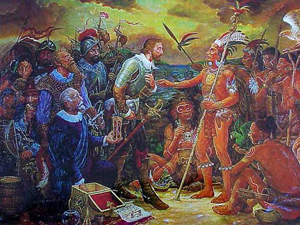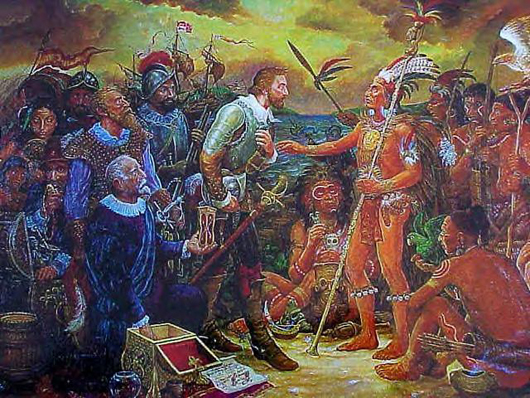
WASHINGTON (AP) – Interior Secretary Ken Salazar is endorsing a federal commission’s call to build a national museum devoted to American Latino art, history and culture next to the Capitol as part of the Smithsonian Institution.
In an interview with The Associated Press ahead of the commission’s report Thursday, Salazar said he would urge Congress to approve creation of the museum. He said such a building on the Capitol’s grounds would be in keeping with the National Park Service’s plan for the National Mall, which calls for overhauling the nearby Capitol reflecting pool as a civic square.
Many contributions of the nation’s Latinos, dating back to before the nation’s founding, have never been recognized, and they deserve a space on the National Mall among the nation’s top cultural attractions, Salazar said.
“My own view is America’s strength in the future is dependent upon America being inclusive of all of its people,” he said. “In the United States today, we have about 50 million-plus Americans who are of Latino descent.”
A copy of the commission’s report obtained by the AP said the museum would represent Latinos where their heritage has been absent at the Smithsonian.
“The mall, more than any other public space in our country does indeed tell the story of America, and yet that story is not complete,” wrote commission chairman Henry R. Munoz III.
A 1994 Smithsonian report entitled “Willful Neglect” found U.S. Hispanics were the only major contributor to American civilization not permanently recognized at the museum complex.
The Latino museum would join the Smithsonian’s National Museum of the American Indian and its planned National Museum of African American History and Culture, slated to open in four years. There has been some hesitance in Congress to add more ethnic museums for fear that they could appeal to segregated audiences.
The commission tried to head off such arguments from the start.
“This is not a museum for Latinos. This is a museum that more fully describes what the American story is,” Munoz said in an interview. “The historical myth of the United States begins with 1776 and the Mayflower, totally ignoring the fact that we were here well before then and have been contributors to the development of this country in every single way.”
Democratic California Rep. Xavier Becerra, who drafted legislation to form the museum commission, said he hasn’t heard any opposition in Congress to creating the museum, though all budget matters will draw attention. It’s an opportunity to “rectify what the Smithsonian will admit was a wrong,” he said.
Becerra, who serves on the Smithsonian Board of Regents, said the board will want to make sure the museum complex will have the resources to handle any new responsibilities and create a high-quality space.
Republican California Rep. Devin Nunes, who is co-chair of the Congressional Hispanic Conference, would be more inclined to support a museum that’s inclusive of all U.S. immigrants, spokesman Andrew House said. Nunes isn’t opposed to a Latino museum but doesn’t think it should be funded by taxpayers at all, due to federal deficits.
Munoz said he envisions a lively, interactive space with performances and perhaps a plaza that allows programs to spill out onto the Capitol grounds.
The commission voted unanimously to recommend the Capitol site over others. It would fall outside an area where Congress has banned any new construction on the mall, officials said.
The report lays out a case for retracing 500 years of Latino history with roots in Europe, Africa, Asia and from indigenous people. It notes Spanish explorers were first to land in Florida decades before English settlers founded Jamestown, and they created outposts that eventually led to the founding of San Francisco and Santa Fe, N.M. It details Latinos’ contributions to the military, the economy and the arts.
At the same time, many groups want to add museums on the National Mall, including efforts to recognize women’s history, gay history and the history of immigration.
“The history of all peoples has got to be told across America,” Salazar said, but the Latino museum proposal was a “definitive plan that addresses the history of 1/6 of the population,” he said.
“We can’t deal with the whole world right now, but I think the time is now to do something like this.”
Federal budget constraints could be the biggest hurdle. The commission’s report calls for building a $600 million museum with Congress providing half the funds and private donations covering the remainder.
Salazar, one of the highest ranking Hispanics in government, pledged to help raise millions of dollars to privately fund the museum’s construction _ and, if necessary, more than half the cost. He previously advocated for the project as a U.S. Senator.
President George W. Bush signed legislation establishing the Latino museum commission in 2008, and President Barack Obama, along with congressional leaders, appointed a 23-member commission. It includes Eva Longoria from TV’s Desperate Housewives, producer Emilio Estefan and others for their expertise in museums, fundraising and Latino culture.
___
Online: www.americanlatinomuseum.org
Copyright 2011 Associated Press. All rights reserved. This material may not be published, broadcast, rewritten, or redistributed.
# # #
ADDITIONAL IMAGE OF NOTE



